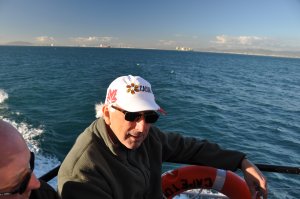Presented By: Cooperative Institute for Great Lakes Research (CIGLR)
Great Lakes Seminar Series: Hugh MacIsaac
Thirty-five years of progress on the Great Lakes: from no policy to global ballast water standards

About the presentation: Expert opinion has placed invasive species as a top stressor of the Great Lakes. Up until the late 1980s, ballast water – the principal pathway (65% of invasions) for species introduction to the system – was unregulated. Invasions by zebra mussels and Eurasian ruffe focused attention of researchers and policy makers on the ballast water threat, resulting in a 1993 USCG policy mandating ballast water exchange (BWE) for vessels entering the system with filled ballast tanks. A retrospective analysis of reported invasions 13 years before and after implementation of the policy shows that new ballast-mediated invasions was virtually unchanged (16 vs 15 species, respectively). Further policy change in 2006 (Canada) and USA (2008) required even vessels with residual ballast water to ‘flush’ open-ocean water through tanks before entry, and coincided with a dramatic decline in new invasions (2 species) over the following 13-year period. This decline is best explained by policy change and not by alternative explanations (shipping volume, source pool depletion, search effort). The International Maritime Organization is presently implementing a new global policy (IMO D-2) based on abundance-based performance standards for different size classes of introduced organisms. The theory behind this policy is based on the well-established principle of ‘propagule pressure’, which defines risk based on the concentration of viable organisms discharged of a single species. However, IMO D-2 is based on ‘community propagule pressure’, a nebulous and unstudied concept, and it ignores the conflating influence of colonization pressure (ie. the number of species introduced). Here I will show that at the concentration of organisms relevant to IMO D-2, colonization pressure has a much greater influence on probability of invasion than ‘community propagule pressure’. I will also examine compliance with the new IMO D-2 standard for zooplankton, and suggest safeguards for the Great Lakes to ensure that vessels do not exceed permissible abundance discharge limits.
About the speaker: Hugh MacIsaac is a professor and Canada Research Chair in Aquatic Invasive Species at the Great Lakes Institute for Environmental Research, University of Windsor (Windsor ON). He also teaches and conducts research at Yunnan University in Kunming, China. Hugh served as director of the CAISN research networks addressing aquatic invasive species in Canada. He has authored over 250 peer-reviewed papers and was honored with the Rigler Award from the Society of Canadian Limnologists. Hugh earned his Ph.D. degree (long ago) from Dartmouth College studying zooplankton ecology. He is interested in a variety of issues pertaining to invasive species including analyses of pathways of introduction, risk assessment, genetic characterization and evolution of invasive species, and management. In his spare time, he and his wife Jaimie enjoy cycling.
About the speaker: Hugh MacIsaac is a professor and Canada Research Chair in Aquatic Invasive Species at the Great Lakes Institute for Environmental Research, University of Windsor (Windsor ON). He also teaches and conducts research at Yunnan University in Kunming, China. Hugh served as director of the CAISN research networks addressing aquatic invasive species in Canada. He has authored over 250 peer-reviewed papers and was honored with the Rigler Award from the Society of Canadian Limnologists. Hugh earned his Ph.D. degree (long ago) from Dartmouth College studying zooplankton ecology. He is interested in a variety of issues pertaining to invasive species including analyses of pathways of introduction, risk assessment, genetic characterization and evolution of invasive species, and management. In his spare time, he and his wife Jaimie enjoy cycling.